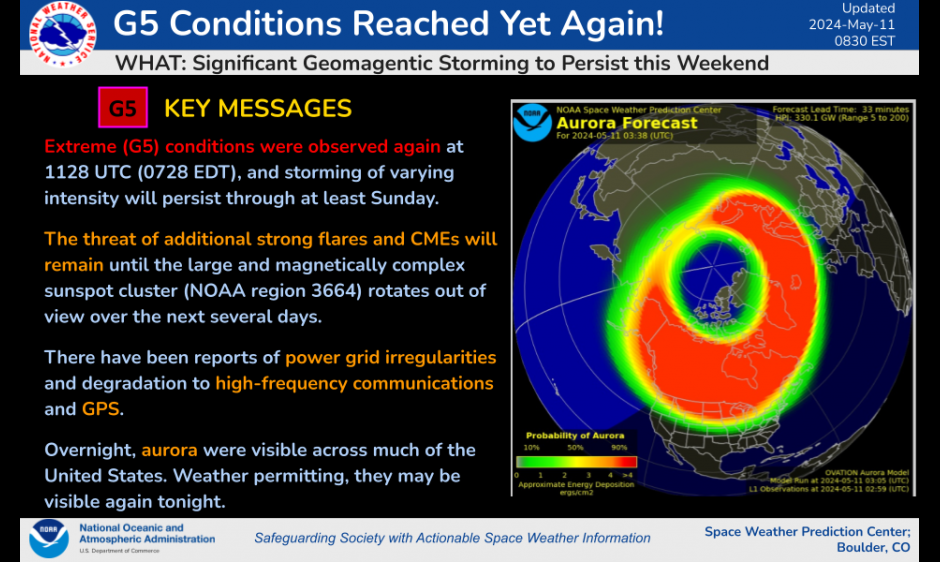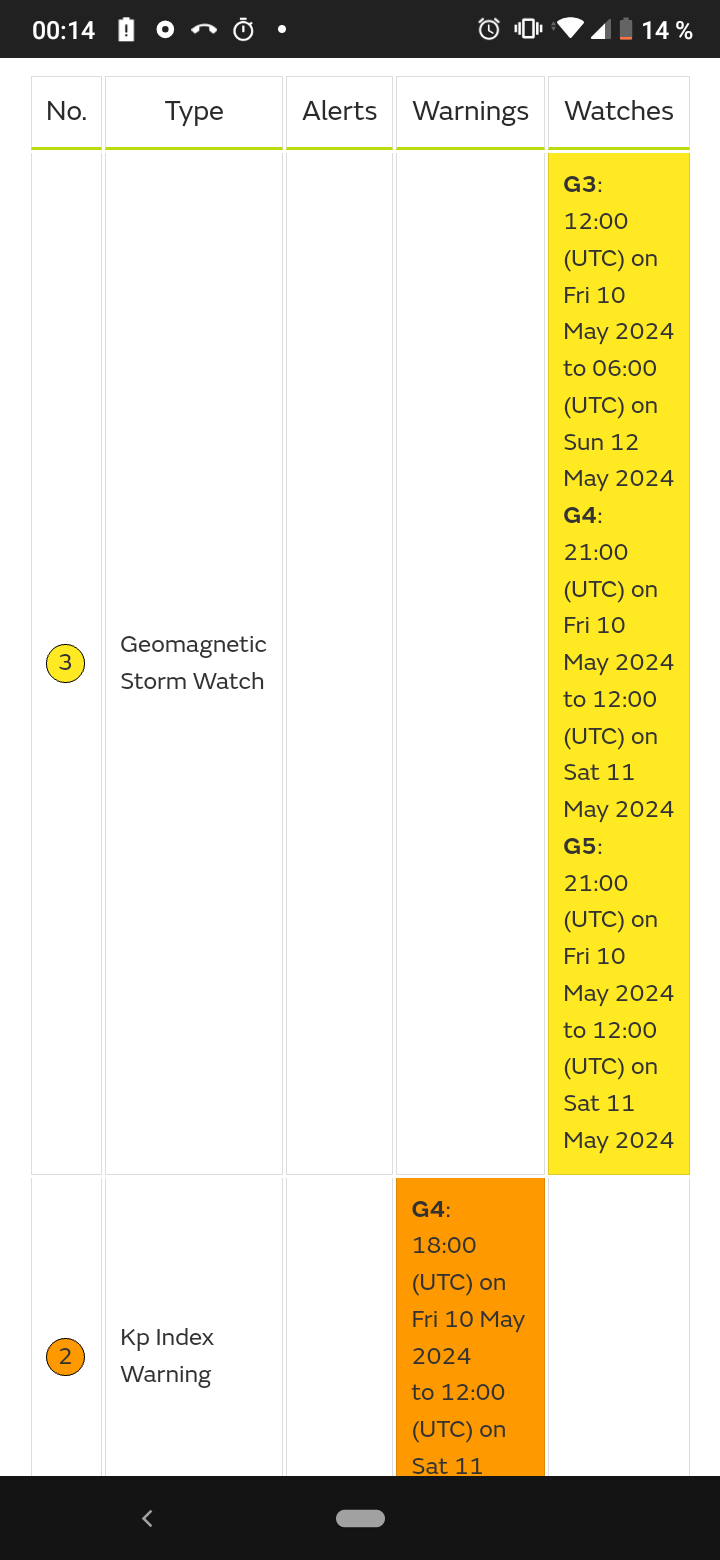
https://www.cnn.com/2024/05/10/world/solar-flares-storms-cme-auroras-scn/index.html
"Previously, a G5, or extreme geomagnetic storm, occurred on October 23, resulting in power outages in Sweden and damaged power transformers in South Africa, according to the center."
Flares emitted from the sun on May 12 UTC or after do not count for this question. However, any flare that was emitted on May 11 counts, even if it arrives at Earth several days later.
🏅 Top traders
| # | Name | Total profit |
|---|---|---|
| 1 | Ṁ39 | |
| 2 | Ṁ34 | |
| 3 | Ṁ29 | |
| 4 | Ṁ27 | |
| 5 | Ṁ26 |
People are also trading
There are still some mildly suspicious power outage reports being investigated (https://www.nzherald.co.nz/whanganui-chronicle/news/more-than-10000-whanganui-homes-affected-by-power-cut-on-sunday-afternoon/L7ITW5ARS5DKXEG3OKCW5Q25TE/), but I'm going to preemptively call this a relative win for the global power grid operators and equipment improvements made over the past few decades. Fun market, even on the losing side of the bet!
I'll refrain from trading further, but I'll still forward along any power outage reports I come across.
@ForTruth I assume "reports of power grid irregularities" are not quite enough to satisfy this market, but it looks indicative.

@ForTruth I am looking for a news article with official information attributing some outage to the storm. Haven't been able to find one yet, but they're forecasting G4/G5 conditions again tonight, which would still count for this question (as the flares were emitted from the sun May 10-11)
@ForTruth This thread indicates there has been "stress" but not "outages", at least in the US: https://twitter.com/whiskerlabs/status/1789362814055821655
Right, and it's also possible we'll see even more flares before the day is done.
At this point it mostly comes down to the odds of some utility company attributing a power outage to the storm rather than to faulty equipment. I found it amusing when Hydro-Québec announced they had weathered the storm with no damage, even while they had multiple power outages due to "equipment failure" with the storm still ongoing. I suppose we'll have to give them the benefit of the doubt.
There's unfortunately a lot of countries to keep an eye on, but I'd expect Canada, Sweden, and Australia/New Zealand to be both the most susceptible and the most likely to give a report in a reasonable timeframe. I'm not sure if it's even possible to check countries like Russia.
@ForTruth I think the sunspot is now close to the edge of the area of the sun facing Earth, and even yesterday's flare was not a direct hit (not sure about this though). Today and tomorrow are probably the last of the impacts
@SaviorofPlant I'm not sure what you mean by a "direct hit", the flare is technically only the xray burst indicating a coronal mass ejection (CME), which spreads out so much that I'm not sure if it makes sense to talk about "direct" or "indirect" hits.
Importantly to this market, CMEs do not travel at the same speed, or even a particularly predictable speed, and fast ones can merge with slower ones. So an intense flare (X10+) within the next few hours could indicate an increase in the intensity of the storm further, without necessarily meaning the storm will last longer. It is also possible for a CME to miss entirely though, which is perhaps what you mean, and one of the many things making this market fun.
So I agree that today and tomorrow are probably the last of the impacts significant enough to affect this market, but I do not agree that the occurrence of another flare would be irrelevant. NOAA technically predicts G3 conditions through the 13th, but I doubt that will be enough to affect this market.
EDIT: Ok, now another flare would probably be irrelevant.
@ForTruth My understanding (which could be wrong, I picked this up trying to piece together what I was reading over the last few days) is that the energy released by a flare is not necessarily evenly distributed over the areas of space it reaches. A "direct hit" would mean that the Earth-directed component of the flare contains a relatively high fraction of that energy, while an "indirect hit" would mean Earth receives significantly less energy than is possible for a flare of the given C / M / X classification.
@SaviorofPlant The C/M/X classification comes from the energy measured from Earth though. I suppose it's possible for a CME to be asymmetrical such that more or fewer particles hit Earth, but I'm not sure any of the models try to predict that.
I'm going to link this in an attempt to clear some things up for you:
https://kauai.ccmc.gsfc.nasa.gov/CMEscoreboard/
You'll notice that this is a very imprecise science, and the fact that we haven't seen another CME hit yet means it's quite possible that we won't. If we do though then it'll likely be stronger than what hit Friday. The half-angular width of these is about 45 degrees, so two are expected to hit together and the CME associated with the X5+ class flare is unusual enough to be unpredictable.
According to the UK Met Office, there is a possibility of a G3 geomagnetic storm that briefly becomes G4, a high likelihood of a G3 geomagnetic storm, and confirmed measurement of an S1 solar radiation storm

In the key, there is only mention of G5 geomagnetic storms causing power outages

Therefore, I estimate a low but non-zero probability
@TheAllMemeingEye It seems odd to rely exclusively on a UK report when such storms hit countries closer to the poles much harder.
@ForTruth They may be a UK-based organisation, but in this case I was paying attention primarily to the global effects column
@TheAllMemeingEye "some protective systems will mistakenly trip out key assets from the grid"
What, exactly, do you think a power outage is, if not this?
@ForTruth hmm, I'll be honest I didn't know what this phrase meant, but it sounds like you reckon it means power outage?
@TheAllMemeingEye "trip out" means disconnect, in the same sense as tripping a circuit breaker.
Most of the uncertainty around this market is in how strong the storm will actually be, and whether energy companies will correctly identify outages as being caused by it.
Personally, I'm of the opinion that it's virtually guaranteed that some power outage will occur somewhere as a result, but actually proving that for some specific outage might be more difficult.
@ForTruth I think we should have more certainty on the strength of the event in a few hours. G3 / G4 events tend to have localized effects, so if it's centered over the Pacific there may not be any outages
@SaviorofPlant I agree that we'll know a lot more in a few hours, but this event will be spread out over days because of its... uniqueness. Plus, we're already firmly in mid-G4 territory. I would not be surprised at all to see this upgraded to a G5 storm.
@SaviorofPlant hmm, why do you think the Met Office are still only mentioning the geomagnetic storm in the forecast 'watch' and 'warning' columns rather than the ongoing confirmed detection 'alert' column? 🤔
@TheAllMemeingEye The NOAA (US agency) has declared a G4 event, not sure if the UK uses different criteria: https://www.swpc.noaa.gov
@SaviorofPlant That NOAA website now says we're observing G5 conditions, but they haven't put out an actual alert. So who knows what's going on anymore.
@ForTruth I think the value is automatically calculated based on the metrics listed on the page, so seems we just crossed whatever their threshold is
@SaviorofPlant Ah, I see. They were just slow. I would have expected them to be faster.
I'm not sure whether to interpret this as you being right about it being largely concentrated over the Pacific and then being over, or if this indicates that the entire storm will be far worse than originally predicted.
@ForTruth Based on the initial articles coming out focusing on US / Europe impacts, I think this was expected to be Atlantic centered, but I read somewhere else that this event is a combination of six different flares, so I'm not really sure where we would expect effects or when it is supposed to peak
@ForTruth Naively I would expect effects wherever it is daylight at the time of high atmospheric CMEs. Not sure if this is correct, but in this case we would expect whatever happens over the next few hours to indeed be Pacific centered and then move to Asia
